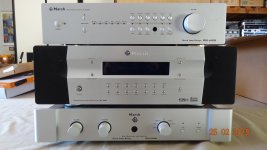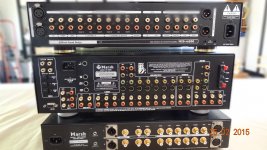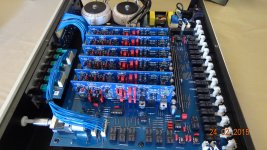I want to say something 'professional' about Richard Marsh: I have known him for about 35 years, and ---- Richard Marsh has designed a number of audio products, and he even had his own company at one time. This includes: amps, preamps, powerline filters, and who knows what else? This is someone who has paid his dues, and he deserves, like everyone else to be addressed in a courteous manner.
That was all quit awhile ago, but I have not stopped contributing.... several more patents and a lot of products.... was CEO of company in Asia that I now consult with in my retirement. But there are still many circuits and products designed, built and sold in Asia only, today. The MARSH name is a registered brand name over there. There have been surround sound, ss and tube preamps, mono blocks of high power and low distortion, stereo PA's of various power levels and multi-channel PA...... VFB and CFB circuits. Power line conditioners and regulators. Updated and some dropped for lack of interest. I pulled these 3 off the shelf in garage to show some of the stuff -- 8 years old and obsolete now. I'll try to get pictures of the current mono-block PA.... just because it is so extreme. I wont answer any questions about them, except they are not sold in USA. All discrete circuits and a few opamps for spec apps.



This is one of the reasons I recently bought a loft/condo in Bangkok. And, shipping a lot of test equipment, I dont use here much, to the factory... I can do R&D here and there.
THx-RNMarsh
Last edited:
Thanks for showing those . I must say interesting , built in US but not sold here. Thanks for your replies in the past to my questions. RegardsThat was all quit awhile ago, but I have not stopped contributing.... several more patents and a lot of products.... was CEO of company in Asia that I now consult with in my retirement. But there are still many circuits and products designed, built and sold in Asia only, today. The MARSH name is a registered brand name over there. There have been surround sound, ss and tube preamps, mono blocks of high power and low distortion, stereo PA's of various power levels and multi-channel PA...... VFB and CFB circuits. Power line conditioners and regulators. Updated and some dropped for lack of interest. I pulled these 3 off the shelf in garage to show some of the stuff -- 8 years old and obsolete now. I'll try to get pictures of the current mono-block PA.... just because it is so extreme. I wont answer any questions about them, except they are not sold in USA. All discrete circuits and a few opamps for spec apps.
View attachment 468184
View attachment 468185
View attachment 468186
This is one of the reasons I recently bought a loft/condo in Bangkok. And, shipping a lot of test equipment, I dont use here much, to the factory... I can do R&D here and there.
THx-RNMarsh
How many non-DS 24 bit converters are out there tho?
To my knowledge, just one, but it is already out of production.
Goodwin's High End - Pacific Microsonics Model Two
To my knowledge, just one, but it is already out of production.
Goodwin's High End - Pacific Microsonics Model Two
Distortion spec indicates 21 bits linear!
Distortion spec indicates 21 bits linear!
must be the capacitors
jn
I would suggest that people who are uncomfortable about the abilities of digital to deliver do some practical listening exercises with heavily attenuated tracks - something I've done many times. A classical piece, with plenty of quiet bits, reduced by 60dB, so only 6 bits used for encoding, a thousandfold drop, 1V becomes 1mV out. I have a Denon CD with this encoded, no dither - worst possible case! And, yes, you can hear the digital chattering on the fades out - at maximum volume, with your ear pressed hard against the speaker cone!! With dither, that chattering would just become benign white noise, not offensive at all. And once the music starts, using 6 bits encoding, it has full integrity, it sounds totally full and whole, perfectly listenable to.If I assume a digital system with x percent distortion during full scale reproduction due to lsb size, if I have a track which is really quiet, like 1% of full scale, won't the lsb distortion be 100 times higher?
I would expect the cleanest sine output to be while using the full 16 bits, but not if the sine is sufficiently low that it uses say, 8 bits.
jn
If you did the same exercise with with tape you would hear massive levels of hiss, with the music buried in it - dithered digital gives you exactly the same, only the hiss is far, far less ...
must be the capacitors
jn
Nah, at those levels it could be iron ore in the next state! In reality 24 bits probably can be achieved, but right now the cost and small market size will not encourage it.
The real issue is using THD as a standard as there are all sorts of issues that will show up in many THD measurements but the actual cause is something else. For example a capacitor with DC across it will to some extent be microphonic. If you do a classic THD + N measurement you maynot pick up the source.
If people are interested in achieving convincing sound, rather than just playing a numbers chasing game, then the focus of effort needs to change. I was fully convinced 30 years ago, from personal experience, that 16 bits did 100% of the job needed, as far as the playback side was concerned. Ongoing chasing of specification "better and better" is just wasting creative and inventive energy - it's a fool's errand. Of course, it may also achieve better sound, but that would just be a fortunate side effect ... 
A "problem" with 16 bit, if you want it call it that, is that the circuitry has to be totally on the ball, no weaknesses anywhere - with 24 bit there is plenty of fat, so poor implementation or less than best performing parts, can mean that major chunks of resolution can be lost with no audible effect.
I was thinking this, because I have another fairly decent Yamaha CD player here, a CD-1050, a cheapie picked up in 2nd hand shop, classic Burr Brown chips. This does show up artifacts in that -60dB track, one channel is fine but the other is relatively poor, quite significant digital chattering, probably down a couple of bits in resolution. But it still sounds perfectly fine when listening to normal level recordings ...
I was thinking this, because I have another fairly decent Yamaha CD player here, a CD-1050, a cheapie picked up in 2nd hand shop, classic Burr Brown chips. This does show up artifacts in that -60dB track, one channel is fine but the other is relatively poor, quite significant digital chattering, probably down a couple of bits in resolution. But it still sounds perfectly fine when listening to normal level recordings ...
A "problem" with 16 bit, if you want it call it that, is that the circuitry has to be totally on the ball, no weaknesses anywhere - with 24 bit there is plenty of fat, so poor implementation or less than best performing parts, can mean that major chunks of resolution can be lost with no audible effect.
WTF are you talking about? So your 24-bit can tolerate some loss of chunks of resolution and end up being ....... 16 bit (ish).
And that is OK?
not many years ago 16 bit DACs in CD players were lucky to hit 14 bits accurately. Whatever the supposed bit depth of the converter these days if I get 16 bits with minimal linearity error I would be very happy.
From what I have seen, a significant number of boutique 24 bit converters are not really accurate above 18-19 bits. My $100 pioneer bluray is probably more accurate than a few of them as well.
Doesn't stop me wanting something based on some of the top line ESS chips though.
From what I have seen, a significant number of boutique 24 bit converters are not really accurate above 18-19 bits. My $100 pioneer bluray is probably more accurate than a few of them as well.
Doesn't stop me wanting something based on some of the top line ESS chips though.
Yes, it is OK, because you're not going to be able to hear anything happening in that 17-24 bit range. If you manipulate the listening situation, amplify an extra low level signal to a very great degree, and listen closely then you will hear something there - however, with a normal music track on, in the same situation, your speakers will be billowing smoke, your ears will be dripping blood, the output stage of your amplifier will have blown a gasket. ie. it's not relevant ...
24 bits would only be relevant to doing some extreme demonstrations of sound phenomena, or listening situations. There's a bloke out there who listens at absurdly loud levels in a home situation, he casually tosses off figures like 130dB at the listening position, thinks nothing of it. And what was his biggest problem? Intrinsic noise levels of the amplifying circuitry - he had to go to major efforts to reduce the hum and murmurings of the analogue components.
24 bits would only be relevant to doing some extreme demonstrations of sound phenomena, or listening situations. There's a bloke out there who listens at absurdly loud levels in a home situation, he casually tosses off figures like 130dB at the listening position, thinks nothing of it. And what was his biggest problem? Intrinsic noise levels of the amplifying circuitry - he had to go to major efforts to reduce the hum and murmurings of the analogue components.
Last edited:
must be the capacitors
jn
No! the resistors.
Some of the best sound I have heard came from sixteen bit DAT done by a pro with 2 Microphones. It was also run through 8 legged Silicon.

As to the 118 dB capture range, we could argue a bit, as I think today the same research would come up with a higher number.
.
Ed, a good challenge for you. Round up a posse and present the research.
Frank, sounds like you're saying, DR is not all that important, providing other aspects, are in order.. You should try some Lp's, played on a good table that is set up properly.. 
I've seen a few people, permanently switch to analogue for main source, after a long frustrating period of trying to find the holy grail, with cd play back..
I've seen a few people, permanently switch to analogue for main source, after a long frustrating period of trying to find the holy grail, with cd play back..
- Status
- Not open for further replies.
- Home
- Member Areas
- The Lounge
- John Curl's Blowtorch preamplifier part II